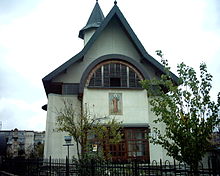

The legend of Saint Andrew in Romania tells that today's territory of Romania was Christianized by Saint Andrew in the 1st century AD. While these claims lack any historical and archeological evidence, the legend has been embraced as fact by both the Romanian Orthodox Church and the Romanian state, both during Ceaușescu's protochronism period and after 1989, when Saint Andrew was named the patron saint of Romania.
The legend is recent[1] and based on references by 3rd century writer Hippolytus of Rome in "On Apostles", mentioning Saint Andrew's voyage to Scythia and on works by several authors which also mention the voyage, such as: Eusebius in the Chronicles of Eusebius,[2] Origen in the third book of his Commentaries on the Genesis (254 C.E.), Usuard in his Martyrdom written between 845-865, and Jacobus de Voragine in the Golden Legend (c. 1260). Scythia generally refers to a land in what is now Romania (Scythia Minor), Ukraine and southern Russia.
- ^ Lucian Boia, History and Myth in Romanian Consciousness, Central European University Press, Budapest, 2001. ISBN 963-9116-96-3, p. 11
- ^ The Library of Eusebius of Caesarea, p234
